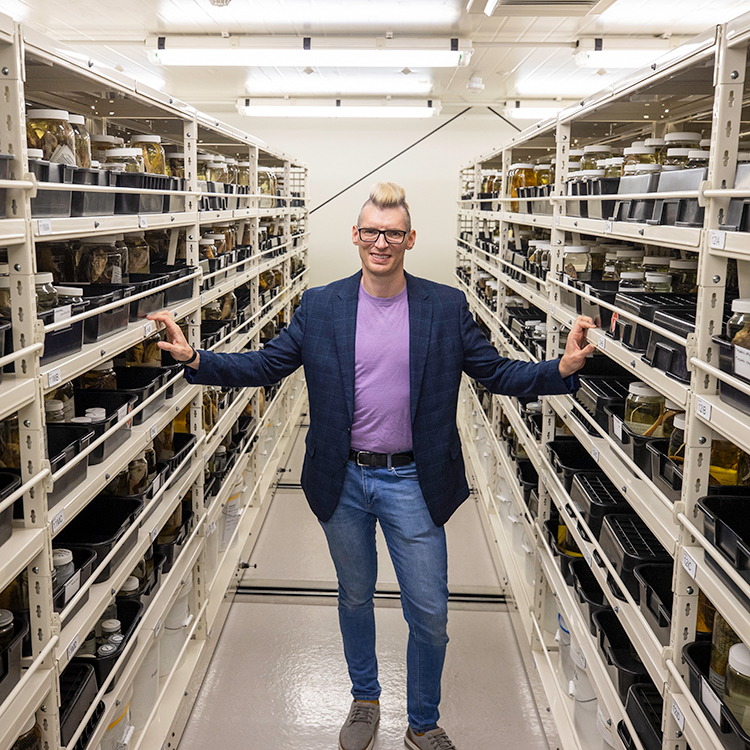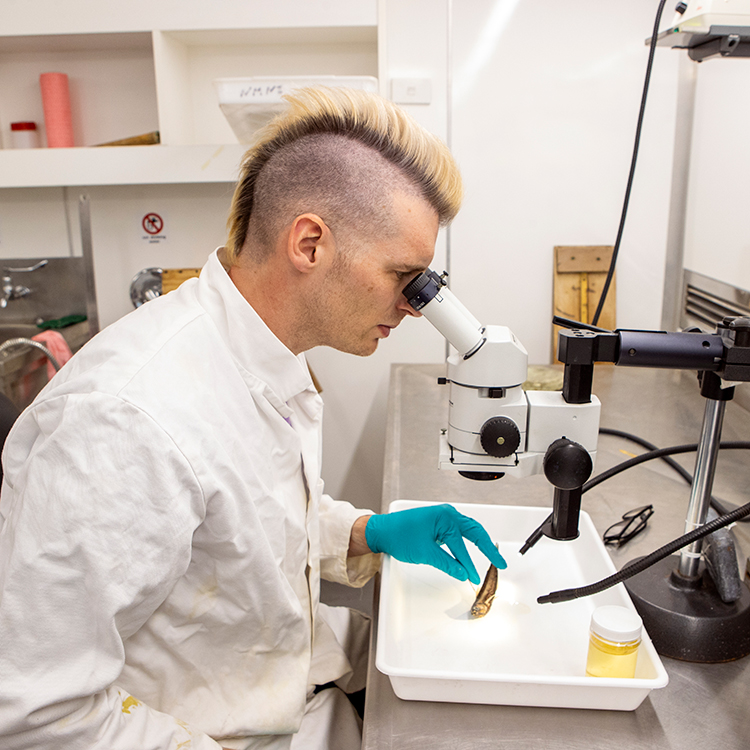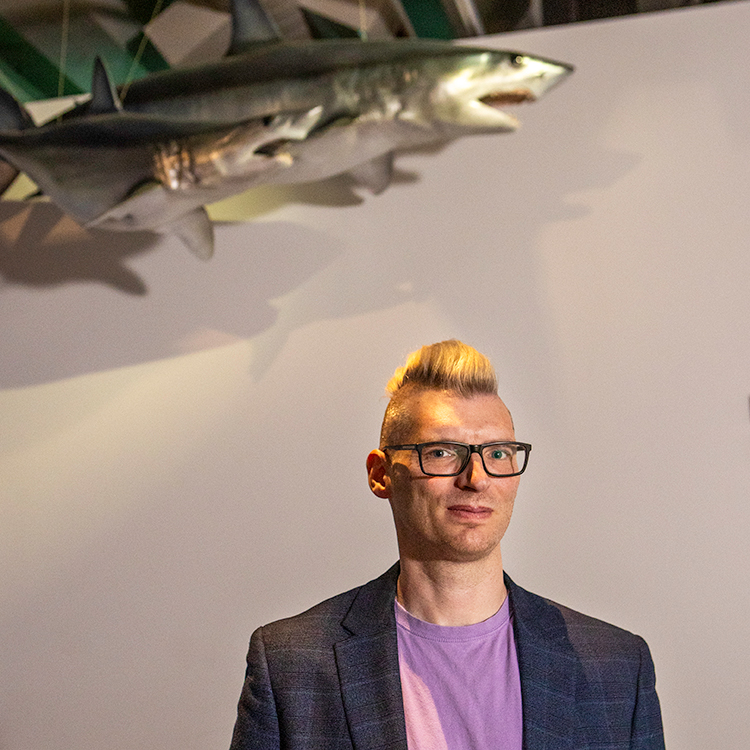
Q&A: Sam the Trap Man
We chat with Sam Gibson, aka Sam the Trap Man, about his conservation work.

Dr Thom Linley is the Curator of Fishes at Museum of New Zealand Te Papa Tongarewa, where the exhibition Breathe | Mauri Ora: An Immersive Journey into Nature by Marshmallow Laser Feast is running until April 27, 2026. The exhibition combines digital art, technology and science. We chat to Dr Linley about his role at the museum.
How did you become the Curator of Fishes at Te Papa?
I did my PhD on deep sea trenches. New Zealand has the wonderful Kermadec Trench running up north, so I came from the UK on two expeditions and I just fell in love with New Zealand. Luckily, I have a very supportive partner, and we took the leap. The job is as good as I’d hoped. I’ve been in this role for about two and half years; I haven’t had a normal day yet.
Can you tell us a bit about your background?
I was researcher at Newcastle University and we expanded into our own deep-sea consultancy. I was a biologist working in really difficult places and the equipment I needed to do my work didn’t exist, so I taught myself some engineering to build it. It’s all very New Zealand ‘Number 8 wire’. The latest thing I built has a battery pack made from a baby food pouch; it shouldn’t work, but it does. We’ve had it down to 2,000 metres and it probably cost about $50.

What do you enjoy about working at Te Papa?
Te Papa is a wonderful place to work. The team wants to acquire knowledge and share that knowledge, so whatever my crazy idea is, as long as it fulfils those two things, my bosses are supportive.
Tell us about your current project.
I’ve teamed up with (Associate Professor) Kat Bolstad from Auckland University of Technology (AUT) who is the New Zealand expert on cephalopods – which are squid and octopus.
I had built a camera system to see shy things that live in deep, open water. My research involved putting bait out, animals came in to eat and we got a photo. But that meant I was only getting the scavengers and only seeing things eating – so I started to think about how I could attract animals in a different way.
I started playing with light; bioluminescence is the major form of communication in the ocean because the deep sea is so huge. Then Kat had the idea to lure in colossal squid using its own light signal, because they’re such shy animals. We got some funding for a collaboration between AUT and Te Papa and last year we went to Antarctica. We’re going again this summer.

What will you be doing in Antarctica?
We’re going with Aurora Expeditions. We will take our cameras and we’ll also be doing water sampling and collecting DNA data, because I’m interested in where New Zealand fauna stops and the South American species start.
We also want to get imagery of a colossal squid. It would be the first time an adult squid is seen alive in its natural habitat. The one in Te Papa was caught in a long line, so we did have footage of it alive, but it was tangled up and unwell on the surface. Last year a juvenile was filmed but we’ve not seen an adult and we’re not sure we’ve seen a male. We’re going to try and attract them by emulating the light signal of the female: we’re going flirting.
Is the colossal squid your favourite creature? Is it classed as a fish – and if not, do you have a favourite fish?
Squid are snails pretending to be fish! On the proper fishy side of things my favourite fish is the Hadal snailfish. They’re little pink fish that live very deep; they’re the deepest vertebrae on earth. I Iike that they buck the trend. When you ask someone to describe a deep-sea fish, they pick the horrible toothy thing with the light. But the world’s deepest fish is adorable. They look they’re smiling, and they’re very social and gregarious.

The exhibition Breathe: Mauri Ora combines art and science. Can you describe the scientific contribution to it?
In science, we have to be very fact-based, very literal; we almost have to remove ourselves from it. For this show, I can inject a bit more of me. I can get a bit giddy and nerdy about just how wonderful life is, how enriching it is to feel connected to the natural world.
Humans like to think we have a good grasp on reality but really we are just designed to stay alive. Our brains are geared toward aiming at prey – throwing spears, that sort of thing – so we have binocular vision, and we can spot red food against a green background. We think we see the world, but we only see a sliver of it.
The natural world is far, far bigger than that.
About a third of the colours in flowers and feathers are beyond our range of vision. If you look at a flower under UV or wider spectrums, there are signs for the pollinators that we are blind to. Some birds that appear quite drab to us actually have many colours under different spectrums (that can be captured using hyperspectral cameras).
Plus, a lot of animal communications are through senses extended beyond ours. Elephants, for example, hear through their feet, and they communicate at frequencies well below what we can hear. There are also whole senses we’re lacking, like electroreception. We think that pigeons have this; when they look at magnetic north, they see a glow on the horizon. They have a compass built into their vision.

How does this relate the exhibition?
The exhibition reveals the hidden world around us. It shows that when you exhale, a tree inhales. It demonstrates that we need each other, and that this relationship has shaped the planet. Everything is in communication, working together. Life on earth is a partnership, a collaboration.
Does it have a positive message, then?
There is an optimistic, inclusive feel to the show. The artists have said they want you to fall in love with nature. We talk about bodies and blood and medical scans but there’s nothing gory. It’s represented through flow. It’s all wonder, all beauty – and relaxation, too. It starts with a meditation.
If you can tell your brain to relax, get into receptive state, you will really see it.
This story is from the Summer 2025 issue of AA Directions magazine.